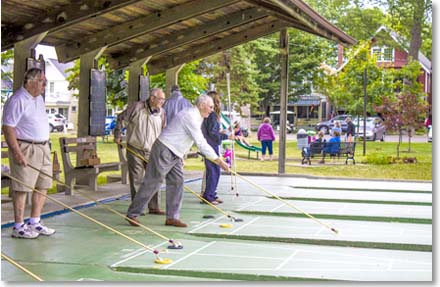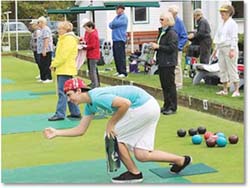

|
Back to |
| The Front Page |
| Letters & Opinion |
|
The Croquet Apocalypse: a Prophet's Warning By Bob Alman posted October 25, 2017
|
||||||||
|
||||||||
The essay below was written and published (on paper) in 1994 at the dawn of the internet age, when the US Croquet Association was barely 17 years old. In the decades since, the tempo of life has changed radically, while the worldwide sport of croquet has become more rigorous and complex--with a few exceptions, including the rise of Golf Croquet, even though it is often disparaged as "pat and chat." Advocates say that a social game is exactly what local clubs need to attract a significant number of new members--especially younger members. National organizations need money to promote and administer the sport; local clubs need local members. Those two imperatives often appear unmanageable and even contradictory. What's to be done? Read on.
"Do you have to be old to play this game?" I was asked by one of a group of 10-year-olds on the other side of the fence at the Oakland lawns watching me run a break.
"No, you don't have to be as old as I am, but you do have to be at least five feet tall, so you can handle the equipment."
It's my standard answer. And yes, I admit I'm an ageist. I don't trust people under 20, and I don't believe most youngsters are mature enough for Association Croquet--that it should be reserved for adults, along with liquor, cigarettes, and certain movies and magazines.
That's just my personal hangup. If it's yours as well, our sport might be in big trouble.
If your lawns are full of players and you can usually find someone agreeable to play with, you may think your croquet club is in great shape and there's no need to enlist new players. But think again: Do you want to play forever with the same people? If you're content with that state of affairs, in a decade or two you will have established an Old Persons Establishment (if you haven't already). The wall around your lawns will be almost insurmountable by any effort of public relations, good works, promotional programs, and well-applied energy. Because almost nobody wants to join an organization of Old People; not even Old People want that.

|
| For shuffleboard, you can sit down between turns. |
Your club will deliberate in meetings to devise one enrollment strategy after another. You'll try them all, and watch each of them fail. Finally you will admit, "We should have tried sooner to get some new people into the club." But it will be too late.
At some point, the person responsible for the financial viability of your playing venue will say to you, "We can't justify the expense of maintaining these lawns; we have many requests for volleyball courts and soccer fields, so we're going to convert the facility and get more people using the space. And we'll spend a lot less on maintenance."
It will have been the right and responsible decision for the management, but it will be the end of your croquet courts.

|
| Here's what it looks like when a really weird young guy takes up an elder's pastime. |
While the media are still discovering the sport of croquet in America and while we still have the chance, we need to get the message across that our is a sport for everyone--not just Old People.
Local clubs--you club--could take the initiative. Ultimately, the Croquet Image--what "everybody knows" about croquet--will be the players passers-by see on your lawns and the photographs snapped by the local press at your tournaments. (All croquet is local.)
The promotion of croquet must continue to stress its broad appeal, bridging the gaps between the sexes and between the generations. In croquet at its best, as in any other sport, competition and camaraderie are mixed and merged in a uniquely absorbing and distinctly human exercise: a competitive game being played for no other reason than the fun of the challenge.
Because we are a new sport growing at a rate of about ten percent a year, the median age of USCA players increases by at least 10 months each year, by my reckoning. People come into the sport from all points of the age spectrum, most of them, I'd estimate, at the level of middle age. Far fewer than 10 percent are dying of "old age" each year; they're just getting older, like you and me. That pretty much describes the pattern of the median age graph. To save croquet from the fate of lawn bowling, the pattern has to be altered.
Look at the pattern. Examine whether and how it applies to your club. Put some creative energy into attracting a continuous influx of younger players. Your club and members of all ages will be the richer for the effort in the 21st Century.
|
POSTCRIPT: The brief life
Although the NCC club had reached the level of about 300 local members, there was plenty of court space on Tuesday late afternoons, and the bar wasn't open because it wasn't a popular time for play. What could possibly go wrong? With the caterer, I made a deal with a popular radio station: their event at our club in exchange for our advertisement for the Five to Nine Club on the radio. The event started well, not with huge numbers, but with just enough to make it viable, so people who came once tended to come again. (I figured that the "optimum number" would be perhaps sixty people, though we could easily have handled more than a hundred. I don't think we ever had more than 40, so there was plenty of growing room.) The event was managed like a "private event," with the non-members required to pay $12 at the door, to include one drink ticket. They could buy additional drinks and food if they wished. There was an incentive to join the NCC club as an "Associate member" which at the time meant a membership limited to Golf Croquet on halfcourts at off-peak times only a few times each week, costing $250.00 a year. In the first two months, about ten of the regular Five to Nine attendees joined the NCC club as an Associate member. Although they were allowed to do croquet in the other playing periods of the category, almost all of them played only on Tuesday evenings at the Five-to-Nine Club. What could possibly go wrong with this plan? I guarded the space religiously, with a sign at the bar entrance which said PRIVATE EVENT, and allowed no older people in the bar, which I avoided myself, as an Old Person, reserving my involvement to teaching Golf Croquet on the adjacent half courts for whoever wanted some instruction. The "pat-and chat" game is, of course, an ideal environment for getting acquainted with a potential date, as well as for networking for business. So I low-keyed the instruction, limiting myself to the basic strokes and the rules, keeping myself unobtrusively available to answer questions. Does this not sound like a brilliant plan? It was, but get this: The event was ended after only 14 weeks by the local "committee" of bigwigs who believed they should manage the club following Chuck Steuber's stroke about 30 months earlier, and who agreed with the "regular members" who said it wasn't "fair" to have the bar open on Tuesday and not allow them to come, too. I protested and said that if we did that, the event would instantly die. I love being a prophet, and who doesn't want events to prove them instantly "right," but I hated it when after only one week, nobody came on Tuesday night except Old People who apparently wanted to be around young people, even though they had nothing in common with them. The Five to Niners came for the last time, saw the old people at the bar, and decided to go to another bar after office hours. The ten or so thirty-something NCC members disappeared forever. (Incidentally, the Tuesday evening at the bar ended, too, because most Old People don't like to drive after sundown, so it was no longer financially viable.) This is a factual story, but I invite you to understand it as a parable that may apply to you and your club. What I have learned in my aged wisdom is that local croquet clubs in their committees tend not to acknowledge that the people who make the rules can change them at any time. They can adjust the prices and privileges of all their membership categories appropriate to current circumstances, to create and sustain viable development ensuring the continued health of the local club as well as the national organization. Today will not last forever! You can acknowledge that your club membership is getting older in tandem with your own aging, and you can intervene to alter the course of the predictable decline of the organism, either biological or organizational. Few if any croquet clubs have the benefit of the extraordinarily appealing environment of the bar and lounge at the National Croquet Center, but many could devise ways to encourage peer-group interaction of younger "working" people on their lawns: but only if you make sure to protect them from Old People! |
The first part of this article is a slightly-edited version of one that appeared in the Croquet Foundation of America's MONOGRAPH SERIES ON CLUB BUILDING, ORGANIZATION, AND MANAGEMENT, published in 1994. The Postscripts are newly digitized by Bob Alman, whose Old Person credentials are unquestioned at the age of 78.
